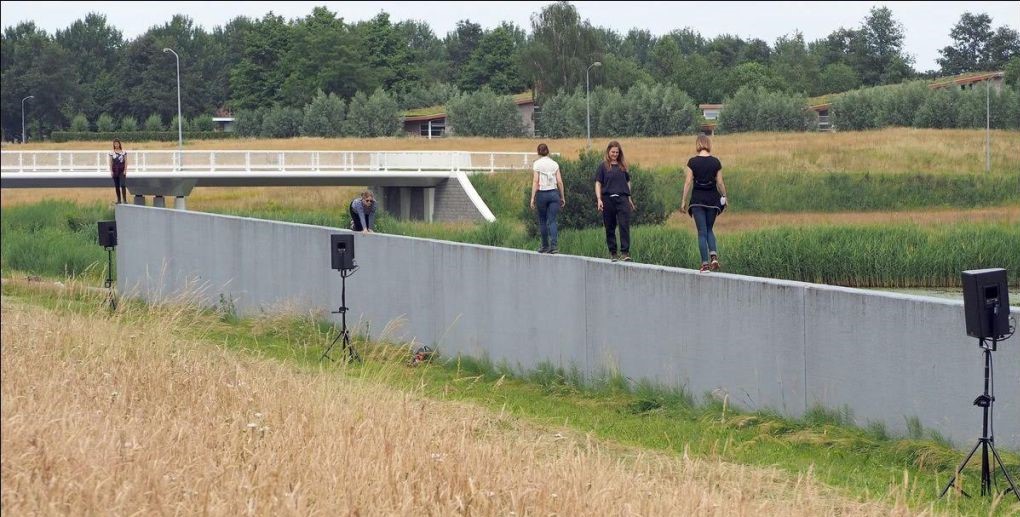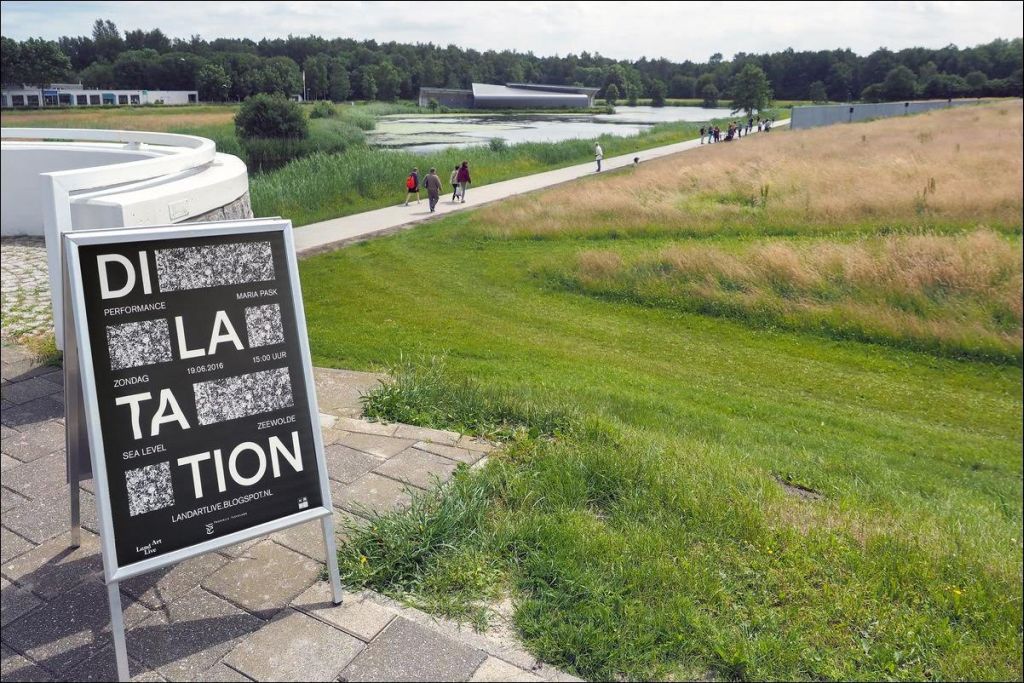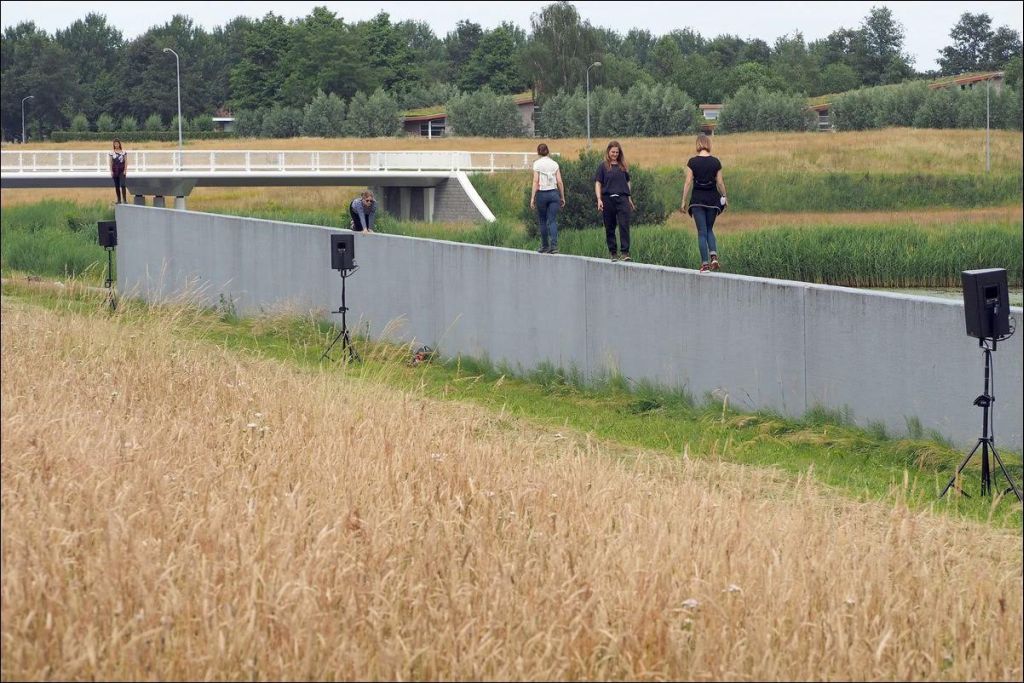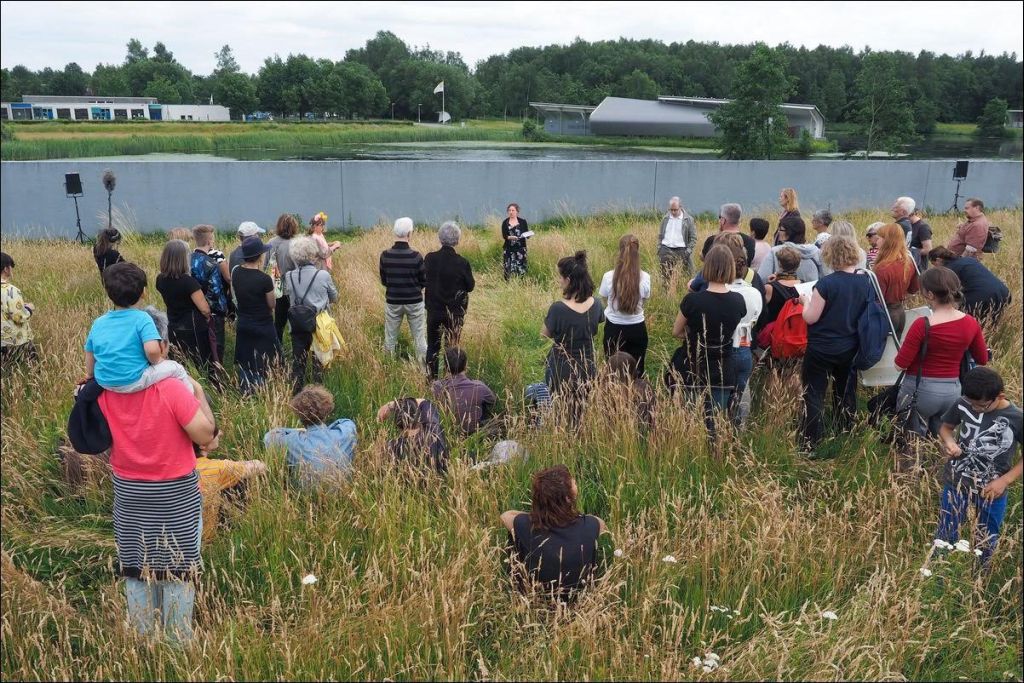
Dilatation or How to reactivate a work by Richard Serra Maria Pask at Land Art Live
To write about an event that you took part in is a tricky task. Inadvertently your observations and thoughts are being blurred by physical and emotional feelings and sensations. However, in the time of participative/performative art this is a condition that is almost impossible to escape. A Sunday in June I viewed Maria Pask’s partially delegated performance Dilatation from that blurry perspective. The performance is part of the curatorial project Land Art Live that investigates the social dimensions of Land Art. Curator Martine van Kampen invites contemporary artists to make performative inventions at one of the six large-scale land art pieces in the Flevopolder. This time, Serra’s Sea Level (1989-1996) had the honor of being revisited.

The site of Sea Level, a park in a residential area of Zeewolde, isn’t exactly spectacular. And yet, Sea Level is renowned as one of Serra’s largest works in public space. The first design dates back to 1989, the year in which Serra’s draining conflict with the General Service Administration of New York City resulted in the demolition of his sculpture Tilted Arc, situated at Federal Plaza in lower Manhattan. Whether this course of events had any bearing on his design for Zeewolde is not known to me, but Sea Level definitively has a more subtle relationship with its surrounds than Tilted Arc. Instead of his favorite material Cor-Ten steel, Serra chose the softer option of concrete, which echoes the work’s architectural surrounds. Sea Level consists of two greyish-blue concrete walls with a length of 200 meter each, situated in extension of each other with a gap of 200 meter in between them. The walls are situated at both sides of a canal in the center of a landscape park. At their outer ends the walls fade into the landscape, whereas at the ends pointing toward each other they are about three meters high. As the title designates, the wall’s height indicates the water level of the lakes that surround the polder.
Serra is renowned for being one of the pioneers of what Rosalind Krauss has termed ‘sculpture in the expanded field’: art that operates in a field of tension between sculpture, architecture and landscape without being reduced to one of these categories. Sea Level is not a sculpture but rather, as Hal Foster has it, “a relay between site and subject that (re)defines the topology of a place through the motivation of a viewer” (Foster, 178). Strolling across the site, viewers experience the work, the site and themselves not as separate entities but in relation to each other, as vectors of a complex and dynamic situation. This relational approach to art is the hinge where Richard Serra’s and Maria Pask’s work meet up. In line with Pask’s earlier work, Dilatation is a collective creative product. The various performers were invited by the artist in the course of her investigations into Serra’s work, his working process and the local community at Zeewolde. Inspired, among other things, by a drawing by the American artist Paul Thek, which reimagines Serra’s grimly Tilted Arc as a friendly and playful mini-fair including a petting zoo, an urban ark for human and non-human beings, Dilatation finally took the form of a mini-festival.
The program started with a short meditation lead by Quantum Vortex Scalar Wave Photon Pulse practitioner Eliaa Jutte, which allowed both audience and performers to make contact with the site and themselves. Writer Rebekka Bremmer recited a poem that evoked the experience of being submerged in water, of losing control and of being overwhelmed. 10-year old Linde Dirks de Groot and Liv Kluiters shone in Play for Two Bears at Sea Level, a Beckettian play written by Adrian Bridget. The two bears dream of the other side of the wall, where obviously the grass is greener and the mangos are juicier. Meanwhile the bears, like two real existentialists, fritter away time squabbling and telling each other jokes.


Maria Pask and myself recited our own variation of Serra’s famous verb list, which describes a series of actions relating to his work process (“to roll, to bend, to crumble, to split”, etc.). Our list was made of two parts. One part was a list of negative behaviors that result in feelings of restriction and disempowerment. This was followed by a list of empowering strategies for positive behavioral changes. Ernestas Kausylas and Miša Skalskis, two sonology students at the Royal Conservatory in The Hague, made Sea Level literally resound. Their sonic piece imbued Serra’s wall with a voice that was wonderfully queer and uncanny.
The local theater-duo ‘Twee Nuchtere Meiden’, consisting of Sandra Knaken and Geke Dijkstra, struck a very different tone with their tongue-in-cheek performance of songs telling about life, love and despair in the polder area. A group of art students at the Royal Academy of Art in The Hague resumed the meditative state with which Dilatation had begun by moving in slow motion on top of the wall from one end to the other. As the performers started simultaneously at both ends of the wall, they inevitably met in the middle, having to find ways of passing each other without losing their balance. The mini-festival ended with a choreography that referred back to the alternative verb list, featuring movements that articulated the emotional impact of the aforementioned positive and negative structures of behavior. After a short demonstration, the audience was invited to join the performers in a group dance.
Dilatation highlights a general strength of Maria Pask’s work, which is bringing together disparate people with different interests, qualities, abilities and disabilities in a fruitful collective creative process. Her work is an ongoing investigation into the nature of the reciprocity between individuals and collectives. The theme of the reciprocity of part and whole is also addressed by the title of her intervention. Dilatation refers to the segmentation of Serra’s concrete walls. Seen from a distance, the walls appear to be made of one piece but seen up close they turn out to be made of 18 separate segments each. These segments are joined together by rubber dilatations. These joints allow the segments to move separately without compromising the stability of the wall. So, the space to move given to the parts secures the stability of the whole structure. To what extent Serra’s post-minimalist idiom is still likely to communicate these matters to a contemporary public in a way that is moving both in a literal and metaphorical sense, is an open question. However, in my view Dilatation succeeded in reactivating Sea Level as well as its site and make them resonate. Serra’s strong masculine gesture is met by Maria Pask with a gesture that is equally strong but articulated in a very different key.
Maria Pask
Dilatations
19 June 2016, Zeewolde at Richard Serra’s Sea Level
a project within the framework of Land Art Live
References
Claire Bishop, “Delegated Performance: outsourcing authenticity”, October, Vol. 140, Spring 2012, pp. 91-112.
Hal Foster, “The Un/making of sculpture”, in Richard Serra: sculpture 1985-1998, ed. Russel Ferguson et al., exhibition catalogue, Los Angeles: The Museum of Contemporary Art; Göttingen: Steidl, 1998, pp. 175-200.
Rosalind Krauss, “Sculpture in the expanded field”, October, Vol. 8, Spring 1979, pp. 30-44.
Harriet Serrie, “Richard Serra’s ‘Tilted Arc’: Art and Non-Art Issues”, Art Journal, Vol. 48, No. 4, Critical Issues in Public Art (Winter, 1989), pp. 298-302.
On Land Art Live see also Landartlive.blogspot.nl
On Paul Thek’s drawing Tilted Ark II (1985) see also http://whitney.org/WatchAndListen/Artists?context=&context_id=&play_id=225
Credits: Maria Pask, Dilatation (performance at Richard Serra’s Sea Level in Zeewolde). Photo: Geert van der Wijk
Anja Novak


